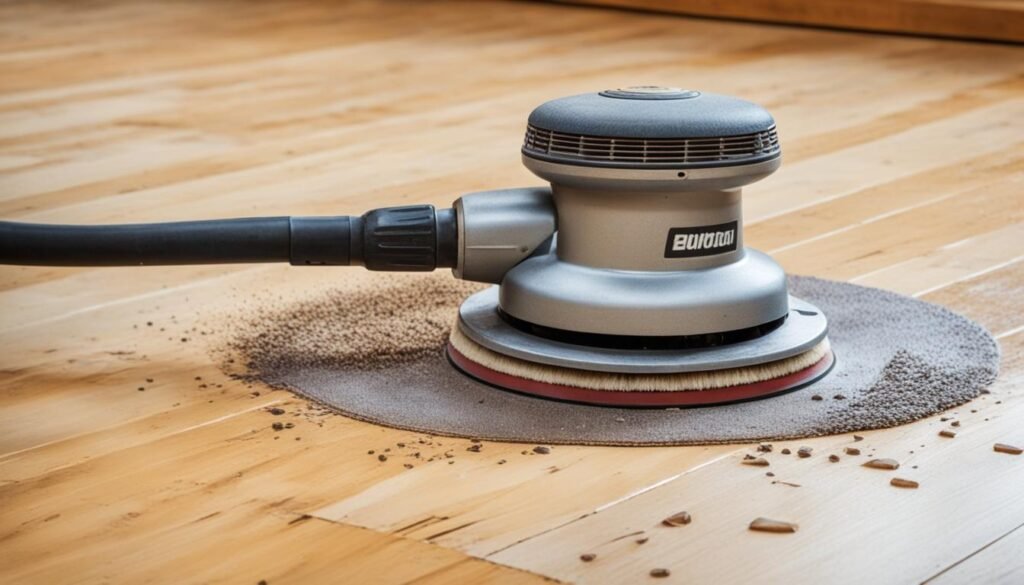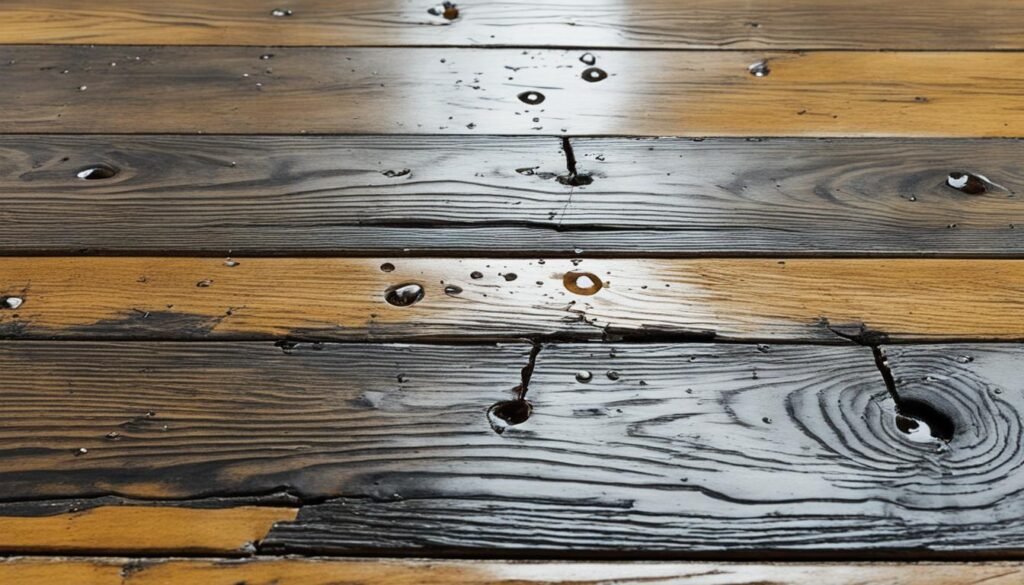Did you know that water damage is a big problem for hardwood floors in the U.S.? It happens when pipes burst, roofs leak, or there’s a big flood. But don’t worry, you can fix your water-damaged floors and make them look new again. This guide will show you how to refinish your floors and give you expert advice for a great result.
Key Takeaways
- Water damage is a common issue that affects hardwood floors in many homes
- Identifying the signs of water damage early is crucial to prevent further deterioration
- Refinishing water-damaged hardwood floors requires specific materials and a step-by-step process
- Proper preparation and attention to detail are essential for a successful refinishing project
- Restoring water-damaged floors can save you the cost of a full floor replacement
Identifying and Assessing Water Damage to Hardwood Floors
Before you start refinishing your water-damaged hardwood floors, it’s key to check the damage. This step helps you figure out the best way to fix it and ensures a lasting repair.
Types of Water Damage
Hardwood floors can face different kinds of water damage, each needing its own fix. Let’s look at the main types:
- Clean Water – This is the simplest to deal with, like from a burst pipe or overflowing sink.
- Gray Water – This comes from appliances like washing machines or dishwashers. It needs careful cleaning and disinfecting to be safe.
- Black Water – The worst kind, black water is full of sewage or floodwater. You’ll need experts to fix it right.
Knowing the type of water damage helps you plan how to fix your hardwood floors.
Signs of Water Damage on Hardwood Floors
Spotting water damage on your hardwood floors is important. Look out for these signs:
- Cupping or Crowning: Boards may curl up or swell in the middle, making the floor uneven.
- Discoloration: Damaged wood can look different colors, with clear water marks or dark spots.
- Warping or Buckling: Too much moisture can make the wood warp, buckle, or lift off the floor.
- Mold or Mildew: Water damage can cause mold and mildew to grow, which harms the wood and is bad for health.
If you see these signs, act fast to stop more damage and keep your floors healthy.
“Identifying and addressing water damage to hardwood floors is the first step in the journey to restoring their beauty and functionality.”
Knowing about water damage types and signs helps you make smart choices for fixing your floors. This leads to a successful repair.
water damage on hardwood floors how to refinish
If your hardwood floors have gotten wet, don’t worry. They can usually be fixed and look great again. It might seem hard, but with the right tools and steps, you can fix your water-damaged floors.
Materials Needed for Refinishing
First, you need to get the right stuff. This includes a moisture meter, fans or dehumidifiers, and plastic sheeting. You’ll also need a shop vacuum, wood bleach, wood putty or filler, sandpaper, paintbrushes or foam applicators, and a stain and finish that match.
Step-by-Step Guide to Refinishing Water-Damaged Floors
- Check how bad the water damage is. Use a moisture meter to see how wet the wood is. Find any spots that need extra work.
- Clean the floor well. Sweep and vacuum to get rid of debris, then use a shop vacuum to suck up any extra moisture.
- If needed, use wood bleach to make discolored spots lighter. Always follow the instructions from the maker.
- Fill in any cracks or gaps with wood putty or filler. Let it dry fully before moving on.
- Start sanding the floor with a coarse grit sandpaper. Keep going to finer grits until it’s smooth and even.
- Vacuum again to get rid of dust or debris left behind.
- Put on a stain if you want, following the instructions from the maker.
- Apply a protective finish like polyurethane or a water-based sealant.
- Let the finish dry fully before you walk on the floor or put your furniture back.
By doing these steps, you can make your water-damaged hardwood floors look new again. Always be careful, work in a place with good air flow, and follow the instructions to make sure it goes well.
| Product | Description | Price |
|---|---|---|
| FloodFixers Hardwood Floor Refinishing Kit | Complete kit with all necessary tools and materials for DIY hardwood floor refinishing | $199.99 |
| Professional Hardwood Floor Refinishing Service | Comprehensive refinishing service by experienced technicians | $3-$8 per square foot |
| Bona Hardwood Floor Cleaner and Refresher | Effective cleaning and rejuvenating solution for maintaining refinished floors | $29.99 |

“Refinishing water-damaged hardwood floors is a great way to breathe new life into your home and increase the value of your property.”
Whether you choose to do it yourself or hire experts, refinishing your floors can change everything. By following the right steps and using the right materials, you can make your water-damaged floors look beautiful again.
Conclusion
Fixing water-damaged hardwood floors is tough, but it can be done with the right steps and care. This guide helps you see how much damage there is, get what you need, and refinish your floors well. Always be careful and get expert help if the damage is too much or you’re not sure what to do next.
You can make your water-damaged floors look new again with time and effort. Restoring them needs hard work, patience, and a wish to keep your floors looking great. By checking the damage, getting the right tools and materials, and refinish your floors well, you can make them look new. This keeps them strong and looking good for a long time.
Fixing hardwood floors damaged by water means acting fast and doing it right. If you ignore the issue or try a quick fix, it can get worse and cost more later. By spending time and resources to refinish your floors well, you protect your investment. This ensures your hardwood floors stay beautiful and work well for years.
FAQ
What types of water damage can affect hardwood floors?
How do I identify water damage on my hardwood floors?
What materials do I need to refinish water-damaged hardwood floors?
How do I refinish water-damaged hardwood floors?
How much does it cost to refinish water-damaged hardwood floors?
FAQ
What types of water damage can affect hardwood floors?
Hardwood floors can face three kinds of water damage: clean water, gray water, and black water. Clean water comes from a burst pipe or sink overflow. It’s the simplest to clean up.
Gray water is from appliances like washing machines or dishwashers. It needs more cleaning and disinfecting. Black water, contaminated with sewage or floodwater, is the most dangerous. It requires expert help.
How do I identify water damage on my hardwood floors?
Look for signs like discoloration, warping, or buckling on your hardwood floors. You might also smell musty or see mold. A moisture meter can show how bad the damage is.
What materials do I need to refinish water-damaged hardwood floors?
You’ll need a moisture meter, fans or dehumidifiers, and plastic sheeting. Also, a shop vacuum, wood bleach, wood putty or filler, and sandpaper in different grits. Don’t forget paintbrushes or foam applicators, and a stain and finish that match your floors.
How do I refinish water-damaged hardwood floors?
First, clean and dry the area well. Then, fix any damage. Sand the floors to prepare them.
Apply wood filler or putty as needed. Finally, stain and finish the floors with a suitable product.
How much does it cost to refinish water-damaged hardwood floors?
Refinishing water-damaged hardwood floors’ cost varies by damage extent, area size, and whether you hire a pro or DIY. Professionals charge to per square foot. Doing it yourself can cost
FAQ
What types of water damage can affect hardwood floors?
Hardwood floors can face three kinds of water damage: clean water, gray water, and black water. Clean water comes from a burst pipe or sink overflow. It’s the simplest to clean up.
Gray water is from appliances like washing machines or dishwashers. It needs more cleaning and disinfecting. Black water, contaminated with sewage or floodwater, is the most dangerous. It requires expert help.
How do I identify water damage on my hardwood floors?
Look for signs like discoloration, warping, or buckling on your hardwood floors. You might also smell musty or see mold. A moisture meter can show how bad the damage is.
What materials do I need to refinish water-damaged hardwood floors?
You’ll need a moisture meter, fans or dehumidifiers, and plastic sheeting. Also, a shop vacuum, wood bleach, wood putty or filler, and sandpaper in different grits. Don’t forget paintbrushes or foam applicators, and a stain and finish that match your floors.
How do I refinish water-damaged hardwood floors?
First, clean and dry the area well. Then, fix any damage. Sand the floors to prepare them.
Apply wood filler or putty as needed. Finally, stain and finish the floors with a suitable product.
How much does it cost to refinish water-damaged hardwood floors?
Refinishing water-damaged hardwood floors’ cost varies by damage extent, area size, and whether you hire a pro or DIY. Professionals charge $3 to $8 per square foot. Doing it yourself can cost $1 to $4 per square foot for materials.
to per square foot for materials.


